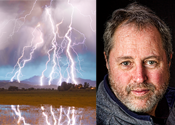Colorado Great Blue Heron, this species usually breeds in colonies, in trees close to lakes or other wetlands like you see in this image. Often such colonies include only Great Blue Herons, sometimes they nest alongside other species of herons. These groups are called heronry (a more specific term than “rookery”). The size of these colonies may be large, ranging between 5â??500 nests per colony, with an average of approximately 160 nests per colony. Heronry are usually relatively close, usually within 4 to 5 km (2.5 to 3.1 mi), to ideal feeding spots. Great Blue Herons build a bulky stick nest, and the female lays three to six pale blue eggs. One brood is raised each year. If the nest is abandoned or destroyed, the female may lay a replacement clutch. Reproduction is negatively affected by human disturbance, particularly during the beginning of nesting. Repeated human intrusion into nesting areas often results in nest failure, with abandonment of eggs or chicks.Both parents feed the young at the nest by regurgitating food. Parent birds have been shown to consume up to four times as much food when they are feeding young chicks than when laying or incubating eggs.Eggs are incubated for around 28 days and hatch asynchronously over a period of several days. The first chick to hatch usually becomes more experienced in food handling and aggressive interactions with siblings, and so often grows more quickly than the other chicks. Predators of eggs and nestlings include turkey vultures, several corvids, hawks, bears and raccoons, the latter two also potential predators of adults. Adult herons, due to their size, have few natural predators, but can be taken by Bald Eagles, Golden Eagles and, less frequently, Great Horned Owls and Red-tailed Hawks. When predation on an adult or chick occurs at a breeding colony, the colony can be abandoned by the other birds, but this does not always occur. Source Wikipedia.
Colorado Fine art nature landscape wildlife photography poster prints, decorative canvas prints, acrylic prints, metal prints, greeting cards and stock images by James Bo Insogna (C) – All Rights Reserved. *PLEASE NOTE, WATERMARKS WILL NOT BE ON THE PURCHASE PRINTS*
Filed under: Wildlife Fine Art Tagged: ‘Colorado nature landscape’, ‘Colorado nature’, animals, bird colony, birds, blue, Boulder County, breeding, breeds, colonies, Colony, Colorado, colorado landscapes, colorado wildlife acrylic prints, Decorative Canvas Prints, fine art, Great, great blue heron, Great Blue Herons, heron, herons, James bo Insogna, Landscapes, nest, nesting, photography prints, trees, Wildlife, wildlife metal prints
![]()





Leave a Reply